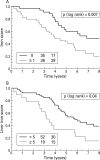Liver iron is predictive of death in alcoholic cirrhosis: a multivariate study of 229 consecutive patients with alcoholic and/or hepatitis C virus cirrhosis: a prospective follow up study
- PMID: 10644325
- PMCID: PMC1727829
- DOI: 10.1136/gut.46.2.277
Liver iron is predictive of death in alcoholic cirrhosis: a multivariate study of 229 consecutive patients with alcoholic and/or hepatitis C virus cirrhosis: a prospective follow up study
Abstract
Background/aims: A study was undertaken of liver biopsy samples from 229 consecutive patients with alcoholic or hepatitis C virus related cirrhosis who were prospectively followed until January 1996 to evaluate the influence of liver iron content on survival and the occurrence of hepatocellular carcinoma.
Methods: Hepatic iron content was measured with a validated semiquantitative score, and its predictive value for survival and the occurrence of hepatocellular carcinoma was assessed.
Results: 130 patients had detectable iron at enrollment. During follow up (57 (28) months), 95 patients died and 39 patients developed hepatocellular carcinoma. No significant relation was found between hepatic iron and the occurrence of hepatocellular carcinoma. Conversely, the presence of iron was predictive of death in alcoholic patients (p = 0.007) by the log rank test but not in patients with hepatitis C virus related (p = 0.71) or mixed (p = 0.98) cirrhosis. The predictive value of hepatic iron content in patients with alcoholic cirrhosis was confirmed by the Cox model using either a binary coding (p = 0.009; relative risk = 2.27; 95% confidence interval 1.2 to 4.19) or the continuous values (p = 0.002).
Conclusions: These results suggest that hepatic iron enhances liver lesions caused by alcohol but not those caused by hepatitis C virus.
Figures


References
Publication types
MeSH terms
Substances
LinkOut - more resources
Full Text Sources
Medical
